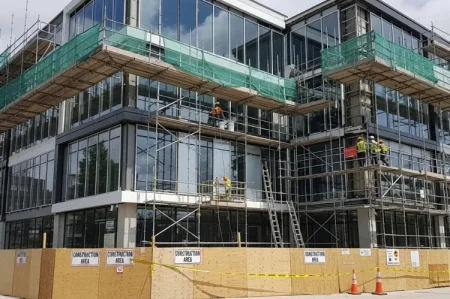Not even 40% of the people who set fitness goals for themselves at the beginning of each year get even halfway to where they’re trying to be. Getting fit is a challenge, and too many people give up before they start seeing progress. It’s tough!
If you’re ready to beat the odds and start getting fit, now’s the time to start. You can build muscle fast as long as you’re consistent and set realistic expectations.
Read on for a few quick tips that can help you reach your goals.
Know Your Goals and Starting Point
If you’re trying to build muscle, you might think that’s a clear enough goal. It’s a decent starting point, but you’ll be able to target your progress if you get more specific.
You may know that if you’re trying to lose fat, you can’t target fat loss. While this is true, you can target muscle growth and development. Muscles won’t grow if you’re not using them.
Let’s say you want to gain muscle in your glutes and thighs. While you’ll want to stay balanced with your workouts (more on that later), you may have a heavier focus on lower body strength training.
Remember that not every type of body is able to look the same. You may struggle to build muscle in the areas that you want, and that’s okay. Gaining strength is partially about aesthetics, but mostly about functionality.
Gaining muscle is a journey, not a destination.
We recommend taking “before photos” when you start your strength-building journey. Results can be difficult to spot if you don’t have a clear image of your starting point in mind. Take photos from the front, the back, and the side, as well as photos of the areas you want to see the most progress in.
Track Your Progress
So you’ve taken your “before photos” and you’re ready to start working out and eating right. It’s time to start tracking your progress.
Every other week or so, you’re going to want to take another set of photos. Some people take photos every week while others take photos once per month. Remember that progress can be slow and bodies fluctuate, so it’s best to not take photos too close together if you think you may get discouraged by a lack of obvious progress.
You can also take measurements and track those. While the scale is helpful for some people, it’s not a great tool, especially if you’re losing fat while building muscle. It’s hard to determine what’s actually happening in your body.
You should also track your workouts. When you’re able to lift heavier, do more reps, or endure your workout for longer, these are all signs of progress.
Develop an Exercise Routine
If you really want to build muscle, you have to exercise. It doesn’t have to be conventional exercise in the gym, but that’s the best and easiest way to go about it. Your primary goal is to get better at picking up heavy things and putting them back down.
But what should this exercise routine look like? Well, you’ll be working out an average of four or five days every week (at least at first). Here are a few tips for getting the most out of your workouts.
Strength Training
Strength training is your top priority if you want to gain muscle. You can certainly build muscle while doing other types of exercise (more on that later), but a solid weightlifting routine is a must-have.
Your lifts are going to be divided into several categories:
- Push (upper body)
- Pull (upper body)
- Leg exercises
- Core exercises
If you’re focusing on building muscle in one specific area, you’ll spend more time on those exercises. You can split up your exercises or do full-body days.
If you’re short on time, several full-body days can be effective, especially if you’re a beginner. If you have time to spare, however, we recommend splitting your upper and lower body days and finding time for a bit of core work during each session.
Focus on heavy lifts. Squats, presses, deadlifts, hip thrusts, and chin-ups are great exercises for building muscle. While it’s best to use free weights or dumbbells, you can also use machines in a pinch, especially if you’re new to working out.
When Should You Increase Your Weights?
At first, you may be sticking with light weights or even bodyweight exercises. Those won’t help you get “swole,” but they will allow you to start building strength so you’re ready for more challenging lifts in the future.
To gain strength, you want to focus on progressive overload. This means that you’re slowly making the exercise more challenging for yourself and gaining strength and endurance in the process.
When it comes to strength training, you’ll likely be adding weight rather than increasing reps. You should always aim for the 8-rep mark (though some people go up to 10). Your last rep should be challenging.
You know you’re ready to add weight when the last rep feels close to as easy as the first one. Add a small amount of weight until the last rep feels almost too difficult, but you can still maintain good form.
How Important Is Staying Balanced?
Many people think that you don’t have to do anything else if you’re strength training, or that you can focus exclusively on the area that you’re training most. This isn’t the case if you want to be well-rounded and have safe workouts.
You should mix up your routine. It should include strength training for other parts of the body, cardio, and even stretching.
Let’s say you only care about improving your lower body. You’re doing deadlifts, squats, and hop thrusts and ignoring everything else. Your workouts will suffer and you’ll put yourself at a greater risk for injury.
Squats and deadlifts require core strength. While the exercises themselves will strengthen your core, doing other core exercises will make your workouts even better.
Having a strong back and strong shoulders will keep you safer while you’re doing those large lower body lifts.
Cardio isn’t important for gaining muscle, but it is important for staying healthy. At the very least, doing a brief cardio workout as a warmup before you lift is a good idea. You can also do high-intensity interval training to get the most out of a brief workout session.
Adjust Your Diet: Getting Swole Starts in the Kitchen
You need to adjust your diet if you want to get swole. A muscle-building diet isn’t just overloaded with calories (though calories are definitely a factor). You need to eat well if you want to gain muscle without also gaining a lot of fat.
So what should you do? Here’s a brief overview of how you should adjust your diet when you’re trying to build muscle fast.
Adjust Your Calorie Intake
If you’re trying to build muscle, you’re going to need to be eating in a calorie surplus. The only exception to this s if you’re a complete beginner. If that’s the case, you can benefit from “newbie gains.” Those “newbie gains” will allow you to build muscle and drop fat without making serious dietary adjustments.
If you want to gain muscle, you have to accept that you’ll also be gaining a small amount of fat unless you’re eating as cleanly as possible. Even with a clean diet, a small amount of fat gain is almost inevitable.
Use a calorie calculator to calculate your daily calorie expenditure. Make sure you factor in your workouts. Add a small number of calories to this number and that will be your everyday calorie goal.
Start with adding 100 calories per day and see if you make progress. Go up in 50-100 calorie increments until you start to see results.
It’s tempting to just eat ice cream and junk food to reach your calorie goals, but you should still eat healthy food. Aim for the 80/20 lifestyle.
Get Your Macros in Check
So what are macros?
Macros are macronutrients. They’re the three categories of food you eat the most: protein, carbohydrates, and fat. When you balance them out, you’ll make better progress with your lifts and overall shape.
Calories in vs calories out are the main thing to keep in mind when you’re gaining weight. If you eat more calories than you expend, you’ll gain weight. However, if you’re trying to build muscle, the quality of those calories matters as well.
It’s a good idea to aim for a diet that’s about 40% protein, 30% fat, and 30% carbs, but this is only a loose guide. Some people prefer to amp up their protein intake for maximum muscle growth while others add more carbs to keep their energy up.
No single area of this should be seriously lacking unless you’re following a special diet (more on that later).
Supplements: Yes or No?
Do you need supplements to build muscle?
In short, no. No one needs supplements to build muscle, but that doesn’t mean that supplements aren’t beneficial. Quite to the contrary, supplements make it easier to get stronger and leaner faster, even if your diet and exercise routine isn’t perfect.
Protein is the most common supplement that people will use. Drinking protein shakes and eating protein bars is a great way to make sure your protein intake is high enough, especially if you don’t have a ton of time to eat during the day or if you’re a vegetarian or vegan.
BCAAs are great for energy and recovery.
You can also try taking SARMs. While SARMs are controversial, they can benefit muscle growth and help you avoid muscle wasting. Learn where to buy ostarine (a popular SARM) to see if it’s right for you.
Do You Need a Special Diet?
You don’t need a special diet to build muscle, but it can help in certain situations. If you’re not already following a specific diet, it may be best to just modify your calories and macros as you go along.
Keto is popular amongst weightlifters, but newbies may discover that the lack of carbohydrates makes lifting heavy weights a real challenge. The high protein content of the diet is great for recovery, but keto is really best for fat loss.
Intermittent fasting is a good idea if you’re trying to lose fat, but not as good if you’re trying to build muscle. It’s difficult to eat as many calories as you’ll need to gain weight in a short period of time.
Get Enough Rest
Rest is necessary for muscle growth, so don’t forget it. There’s a reason that you’re not lifting weights every day.
When you’re done lifting for the day, your muscles start repairing themselves. The food you eat helps with that process, but your muscles won’t be able to completely repair if you keep working on them every day.
You don’t have to have a complete rest day between every workout. If you worked on your legs the day before, you’ll let your legs rest while you work on your arms. If your arms and legs are both sore, you may do light cardio, pilates, or even yoga.
Don’t overwork yourself or you may burn out.
Do You Want to Build Muscle Fast?
If you’re ready to build muscle fast, keep this guide in mind. Remember, it’s a combination of diet, exercise, and rest. Gaining muscle takes a lot of time, but if you’re consistent, that time will be worthwhile.
Get to the gym, start meal planning, and get fit!
For more helpful articles about health, fitness, and more, visit the rest of the site.






